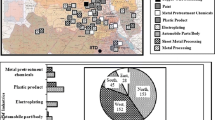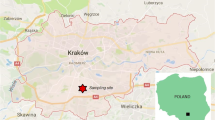Abstract
Speciated samples of PM2.5 were collected at the Big Bend site from July of 2003 to June 2006 and the McDonald Observatory site from July of 2003 to August of 2005 in southwestern Texas, respectively, by the US Environmental Protection Agency. A total of 175 samples for the Big Bend site and 105 samples for the McDonald Observatory site with 52 species were measured; however, 30 and 32 species from the Big Bend and McDonald Observatory sites, respectively, were excluded because of too much below-detection-limit data. Due to the laboratory change about November 1 of 2004 and possible analytical artifacts, phosphorous was excluded as well. Among the species excluded, 31 species are common to both sites. The two data sets were analyzed by positive matrix factorization to infer the sources of PM observed at the two sites. The analysis resolved five source-related factors for Big Bend and four for McDonald Observatory. Sulfate-rich secondary aerosol, coal burning, motor vehicle/road dust, and a mixed factor were identified as common sources to both sites. The other factor identified for Big Bend is related to soil. Sulfate mainly exists as ammonium salts. The sulfate-rich secondary aerosols account for about 62% and 66% of the PM2.5 mass concentration at the two sites, respectively. The highest concentration of Si associated with Ca, Fe, \({\text{SO}}_4^{2 - } \), and organic carbon at the two sites was possibly attributed to the coal-fired power plants in the region. Basically, the factor of sulfate and coal burning at the two sites showed similar chemical composition profiles and seasonal variation that reflect the regional characteristics of these sources. The regional factors of sulfate, coal burning, and soil showed predominantly low-frequency variations; however, the area-related and/or local factors showed both high and low frequency variations. The motor vehicle/road dust and the mixed factors were likely to be area-related and/or local source.








Similar content being viewed by others
References
Anttila, P., Paatero, P., Tapper, U., & Järvinen, O. (1995). Source identification of bulk wet deposition in Finland by positive matrix factorization. Atmospheric Environment, 29, 1705–1718. doi:10.1016/1352-2310(94)00367-T.
Ashbaugh, L. L., Malm, W. C., & Sadeh, W. Z. (1985). A residence time probability analysis of sulfur concentrations at Grand Canyon National Park. Atmospheric Environment, 19(8), 1263–1270. doi:10.1016/0004-6981(85)90256-2.
BRAVO Study. (2004). Big bend regional aerosol and visibility observational study. US EPA, NPS, and TCEQ.
Chiou, P., Tan, W., Lin, C. J., Chu, H. W., & Ho, T. C. (2007). Atmospheric aerosol over a southeastern region of Texas: Chemical composition and possible sources. Environmental Modeling and Assessment. doi:10.1007/s10666-007-9120-8.
Chiou, P., Tan, W., Lin, C. J., Chu, H. W., Tadmor, R., & Ho, T. C. (2008). Atmospheric aerosols over two sites in a southeastern region of Texas. Canadian Journal of Chemical Engineering, 86, 421–435. doi:10.1002/cjce.20047.
Chueinta, W., Hopke, P. K., & Paatero, P. (2000). Investigation of sources of atmospheric aerosol at urban and suburban residential areas in Thailand by positive matrix factorization. Atmospheric Environment, 34, 3319–3329. doi:10.1016/S1352-2310(99)00433-1.
Efron, B., & Tibshirani, R. L. (1993). An introduction to the bootstrap. London: Chapman and Hall.
Eskridge, R. E., Ku, J. Y., Rao, S. T., Porter, P. S., & Zurbenko, I. G. (1997). Separating different scales of motion in time series of meteorological variables. Bulletin of the American Meteorological Society, 78, 1473–1483. doi:10.1175/1520-0477(1997)078<1473:SDSOMI>2.0.CO;2.
Hansen, D. A., Edgerton, E. S., Hartsell, B. E., Jansen, J. J., Kandasamy, N., Hidy, G. M., et al. (2003). The Southeastern aerosol research and characterization study: Part 1—overview. Journal of the Air & Waste Management Association, 53, 1460–1471.
Hies, T., Treffeisen, R., Sebald, L., & Reimer, E. (2000). Spectral analysis of air pollutants. Part 1: elemental carbon time series. Atmospheric Environment, 34, 3495–3502. doi:10.1016/S1352-2310(00)00146-1.
Hopke, P. K. (1985). Receptor modeling in environmental chemistry. New York: John Wiley & Sons.
Hopke, P. K. (1991). Receptor modeling for air quality management. Amsterdam: Elsevier Science.
Hopke, P. K., Lamb, R. E., & Natusch, D. F. S. (1980). Multielemental characterization of urban roadway dust. Environmental Science & Technology, 14, 164–172. doi:10.1021/es60162a006.
Huber, P. J. (1981). Robust statistics. New York: Wiley.
Juntto, S., & Paatero, P. (1994). Analysis of daily precipitation data by positive matrix factorization. Environmetrics, 5, 127–144. doi:10.1002/env.3170050204.
Kim, E., Hopke, P. K., & Edgerton, E. S. (2003). Source identification of Atlanta aerosol by positive matrix factorization. Journal of the Air & Waste Management Association, 53, 731–739.
Kim, E., Hopke, P. K., & Edgerton, E. S. (2004). Improving source identification of Atlanta aerosol using temperature resolved carbon fractions in positive matrix factorization. Atmospheric Environment, 38, 3349–3362. doi:10.1016/j.atmosenv.2004.03.012.
Lee, E., Chan, C. K., & Paatero, P. (1999). Application of positive matrix factorization in source apportionment of particulate pollutants in Hong Kong. Atmospheric Environment, 33, 3201–3212. doi:10.1016/S1352-2310(99)00113-2.
Liu, W., Wang, Y. H., Armistead, R., & Edgerton, E. S. (2005). Atmospheric aerosol over two urban–rural pairs in the southeastern United States: Chemical composition and possible sources. Atmospheric Environment, 39, 4453–4470. doi:10.1016/j.atmosenv.2005.03.048.
Paatero, P. (1997). Least squares formulation of robust, non-negative factor analysis. Chemometrics and Intelligent Laboratory Systems, 37, 23–35. doi:10.1016/S0169-7439(96)00044-5.
Paatero, P., & Tapper, U. (1993). Analysis of different modes of factor analysis as least squares fit problems. Chemometrics and Intelligent Laboratory Systems, 18, 183–194. doi:10.1016/0169-7439(93)80055-M.
Paatero, P., & Tapper, U. (1994). Positive matrix factorization: a non-negative factor models with optimal utilization of error estimates of data values. Environmetrics, 5, 111–126. doi:10.1002/env.3170050203.
Pasquill, F. (1974). Atmospheric diffusion. Chichester: Wiley.
Paterson, K. G., Sagady, J. L., Hooper, D. L., Bertman, S. B., Carroll, M. A., & Shepson, P. B. (1999). Analysis of air quality data using positive matrix factorization. Environmental Science & Technology, 33, 635–641. doi:10.1021/es980605j.
Polissar, A. V., Hopke, P. K., Malm, W. C., & Sisler, J. F. (1996). The ratio of aerosol optical absorption coefficients to sulfur concentrations, as an indicator of smoke from forest fires when sampling in polar regions. Atmospheric Environment, 30, 1147–1157. doi:10.1016/1352-2310(95)00334-7.
Polissar, A. V., Hopke, P. K., Paatero, P., Kaufman, Y. J., Hall, D. K., Bodhaine, B. A., et al. (1999). The aerosol at Barrow, Alaska: long-term trends and source locations. Atmospheric Environment, 33, 2441–2458. doi:10.1016/S1352-2310(98)00423-3.
Polissar, A. V., Hopke, P. K., Paatero, P., Malm, W. C., & Sisler, J. F. (1998). Atmospheric aerosol over Alaska: 2. Elemental composition and sources. Journal of Geophysical Research, 103, 19045–19057. doi:10.1029/98JD01212.
Polissar, A. V., Hopke, P. K., & Poirot, R. L. (2001). Atmospheric aerosol over Vermont: Chemical composition and sources. Environmental Science & Technology, 35, 4604–4621. doi:10.1021/es0105865.
Prospero, J. M. (2001). African dust in America. Geotimes, 46, 24–27.
Ramadan, Z., Eickhout, B., Song, X. H., Buydens, L. M. C., & Hopke, P. K. (2003). Comparison of positive matrix factorization and multilinear engine for the source apportionment of particulate pollutants. Chemometrics and Intelligent Laboratory Systems, 66, 15–28. doi:10.1016/S0169-7439(02)00160-0.
Ramadan, Z., Song, X. H., & Hopke, P. K. (2000). Identification of sources of Phoenix aerosol by positive matrix factorization. Journal of the Air & Waste Management Association, 50, 1308–1320.
Rao, S. T., Zurbenko, I. G., Neagu, R., Porter, P. S., Ku, J. Y., & Henry, R. F. (1997). Space and time scales in ambient ozone data. Bulletin of the American Meteorological Society, 78, 2153–2166. doi:10.1175/1520-0477(1997)078<2153:SATSIA>2.0.CO;2.
Rotach, M. W. (1995). Profiles of turbulence statistics and above an urban street canyon. Atmospheric Environment, 29, 1473–1486. doi:10.1016/1352-2310(95)00084-C.
Schlink, U., Herbarth, O., & Tetzlaff, G. (1997). A component time-series model for SO2 data: Forecasting, interpretation, and modification. Atmospheric Environment, 31, 1285–1295. doi:10.1016/S1352-2310(96)00306-8.
Song, X. H., Polissar, A. V., & Hopke, P. K. (2001). Sources of fine particle composition in the northeastern US. Atmospheric Environment, 35, 5277–5286. doi:10.1016/S1352-2310(01)00338-7.
Sun, L., & Wang, M. (1996). Global warming and global dioxide emission: an empirical study. Journal of Environmental Management, 46, 327–343. doi:10.1006/jema.1996.0025.
US EPA. (2002). SPECIATE version 3.2. US Environmental Protection Agency, Research Triangle Park, NC.
Vermeire, T. G., et al. (1997). European Union system for the evaluation of substances: principles and structure. Chemosphere, 34, 1823–1836. doi:10.1016/S0045-6535(97)00017-9.
Watson, J. G., Chow, J. C., & Houck, J. E. (2001). PM2.5 chemical source profiles for vehicle exhaust, vegetative burning, geological material, and coal burning in northwestern Colorado during 1995. Chemosphere, 43, 1141–1151. doi:10.1016/S0045-6535(00)00171-5.
Xie, Y. L., Hopke, P. K., Paatero, P., Barrie, L. A., & Li, S. M. (1999). Identification of source nature and seasonal variations of Arctic aerosol by positive matrix factorization. Journal of the Atmospheric Sciences, 56, 249–260. doi:10.1175/1520-0469(1999)056<0249:IOSNAS>2.0.CO;2.
Yakovleva, E., Hopke, P. K., & Wallace, L. (1999). Receptor modeling assessment of PTEAM data. Environmental Science & Technology, 33, 3645–3652. doi:10.1021/es981122i.
Zheng, M., Cass, G. R., Schauer, J. J., & Edgerton, E. S. (2002). Source apportionment of PM2.5 in the southeastern United States using solvent-extractable organic compounds as tracers. Environmental Science & Technology, 36, 2361–2371. doi:10.1021/es011275x.
Acknowledgements
This study was supported in part by the US Department of Agriculture through Sul Ross State University CSREES #2006-38899-03586. The authors wish to thank Professor Hopke of Clarkson University for helpful e-mail communications. The result of this research represents only the authors’ assessments and does not reflect the funding agency’s views on the air quality issues in this region.
Author information
Authors and Affiliations
Corresponding author
Rights and permissions
About this article
Cite this article
Chiou, P., Tang, W., Lin, CJ. et al. Atmospheric Aerosols over a Southwestern Region of Texas. Environ Model Assess 14, 645–659 (2009). https://doi.org/10.1007/s10666-008-9169-z
Received:
Accepted:
Published:
Issue Date:
DOI: https://doi.org/10.1007/s10666-008-9169-z




